How do you judge whether you’re ready for digital transformation? Is there assurance that your enterprise has a pro-change culture? The feeling that the time is right and that your enterprise is skilled at digital adaptation?
Assessing readiness for a transformation can often be more important than simply using a wish and a prayer. This approach allows you to prepare for the transformation by evaluating your maturity and what stage you are sitting at to know how to plan for the future.
Predictions suggest that the global digital transformation market will grow with a CAGR of 24.1% to USD 3.1 billion by 2030, so now is the time to consider the maturity model to ensure your investment won’t result in wasted resources.
This article will explore what the digital transformation maturity model is, why you need it, the five levels of digital transformation maturity, the six dimensions of the model, how to conduct a digital transformation maturity model assessment, the distinction between digital transformation and digital maturity, and the subsequent steps after assessing your digital transformation maturity.
- What is the digital transformation maturity model?
- Why do you need the digital transformation maturity model?
- What are the 5 levels of digital transformation maturity?
- What are the dimensions of the digital transformation maturity model?
- How to do a digital transformation maturity model assessment
- What is the difference between digital transformation and digital maturity?
- What do you do after you assess your digital transformation maturity?
- The ongoing commitment to digital maturity and organizational excellence
What is the digital transformation maturity model?
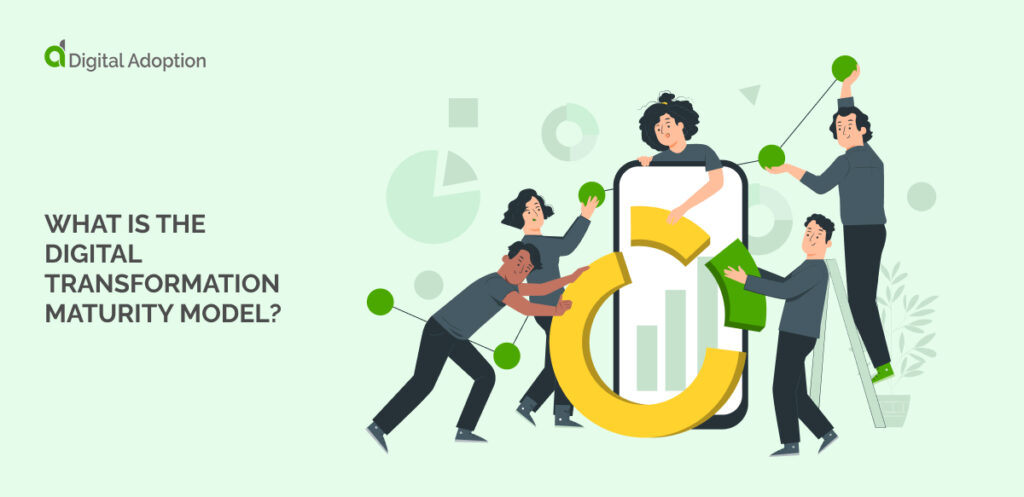
A digital transformation maturity model allows organizations to assess their ability to respond quickly to developments and shifting technology trends.
The model focuses on creating value fast enough through these new capabilities and customer needs to maintain a competitive advantage over rivals. Digital maturity requires investing in the tools and human resources to leverage new technology optimally.
Why do you need the digital transformation maturity model?
Digital maturity is an essential concept to assess in your organization as it helps you prepare for significant digital transformations and reduce waste by allowing you to see why you aren’t ready. In this situation, you can see your stage on the model and take action to prepare for fast ROI and transformation success.
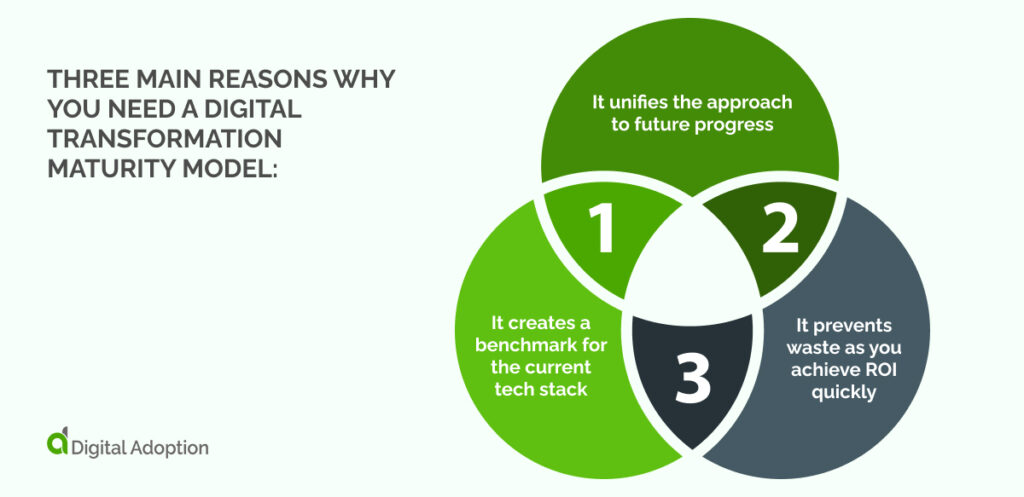
There are three main reasons why you need a digital transformation maturity model:
- It creates a benchmark for the current tech stack: A DMM acts as your sophisticated compass, pinpointing your existing tech stack’s strengths and weaknesses against industry benchmarks.
- It unifies the approach to future progress: Without a unified blueprint, the project descends into chaos. A DMM serves as your shared architectural plan, aligning stakeholders around a common vision for future progress.
- It prevents waste as you achieve ROI quickly: A DMM empowers you to navigate the maze of digital transformation, unlocking rapid ROI from your digital investments. By prioritizing high-impact initiatives and eliminating wasteful spending, you reach your digital transformation KPIs faster and maximize the value of every resource.
A digital transformation maturity model must form the core of your roadmap for the future, as you use it to fundamentally reshape how you design products and services. This point underscores the need for organizations to assess their digital maturity level accurately.
Furthermore, digital organizations hold immense potential to alleviate workforce pressures, bridge customer access and outcome disparities, shrink your enterprise’s environmental footprint, and even bolster organizational resilience against climate change and pandemics.
What are the 5 levels of digital transformation maturity?
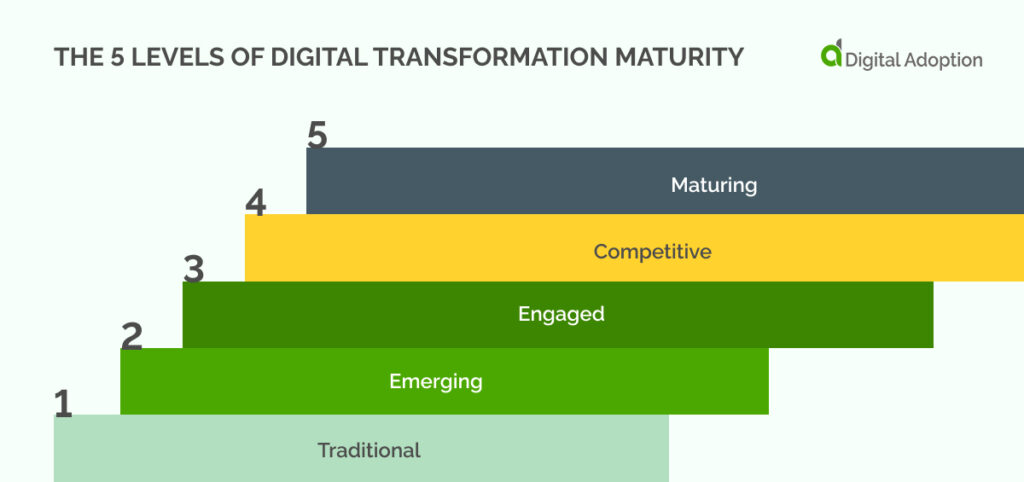
There are five levels of digital transformation maturity that you can use to ensure you are ready for a successful transformation.
If you are not at the final stage, don’t worry; using the model can help you decide the next steps when establishing where you are on the scale.
Let’s explore:
1. Traditional
Typically, you are at the traditional digital transformation maturity model stage if you are:
- Lagging in technology adoption and business practices.
- Limited use of digital tools and reactive approach to change.
- Lack of strategic intent for digital transformation and vulnerable to disruption.
- There is an urgent need to develop a plan and raise awareness across the organization.
2. Emerging
You may be in the emerging stage of the model if your organization is in the following position:
- The gradual adoption of digital technologies in pockets of the business.
- Primarily reactive to emerging trends and competitor actions.
- Struggling to keep pace with the accelerating pace of digital change.
- You need to prioritize strategic digital transformation to avoid future limitations.
3. Engaged
The third stage of the model is ‘engaged,’ where you will notice that your organization exhibits the following characteristics:
- Experimenting with key elements of a successful digital strategy.
- Implementing foundational activities and isolated pockets of innovation.
- Often, siloed efforts lack a unified vision or leadership.
- Require a cohesive plan for driving the adoption of a singular digital vision.
- Key stakeholders need to collaborate on a structured transformation roadmap.
4. Competitive
When you are at the competitive level, you have worked hard to nearly be fully mature and ready to progress to the fifth and final level.
In the fourth stage, you will notice these achievements for your organization:
- Established digital roadmap effectively addresses current disruption.
- Compete effectively in the current market but lack a future growth strategy.
- Focus on optimization and removing roadblocks to launching new digital offerings.
- Need to develop a strategy for continuous innovation to leapfrog competitors.
5. Maturing
Maturing is exactly where you want to be, as you are ready to undergo any digital transformation successfully and instantly reap the rewards without wasting resources or encountering employee resistance to change.
- A well-defined and adaptable transformation roadmap ensures resilience against disruption.
- Leverage digital technologies to drive business operations and continuous change.
- Focus on optimizing delivery processes and removing friction points.
- Agile and responsive to market trends, delivering new digital experiences rapidly.
- Aim to become industry leaders by unlocking full potential through continuous transformation.
What are the dimensions of the digital transformation maturity model?
Understanding your digital maturity hinges on mastering these six key dimensions. Imagine them as interlocking gears, each crucial for propelling your organization toward seamless transformation.
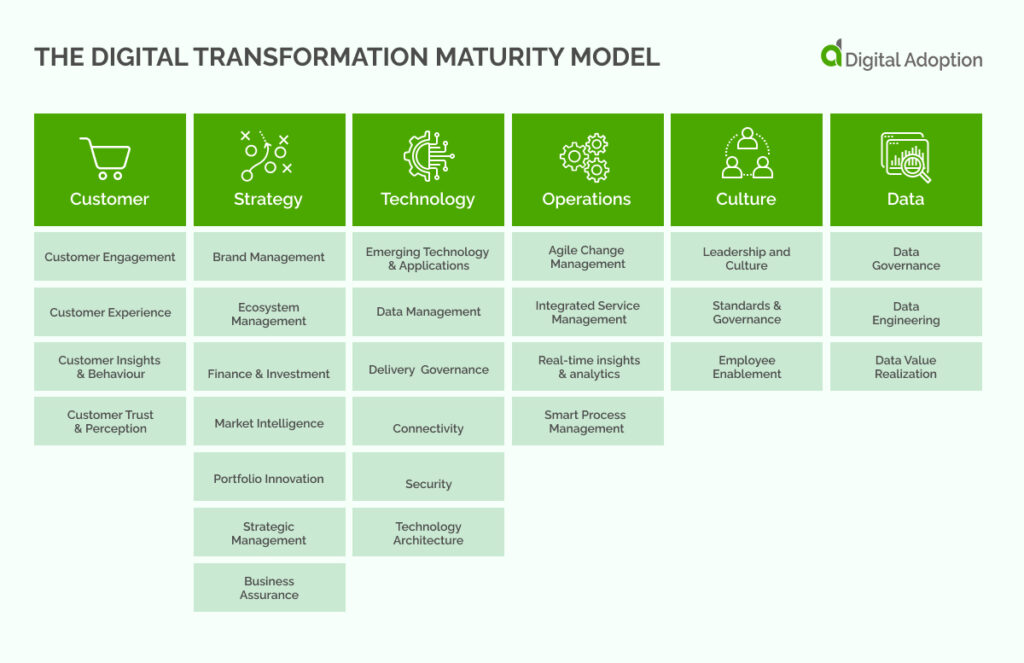
Customer
Think of a handshake at the crossroads of the physical and digital worlds. Here, customers find an empathetic digital partner readily available on their preferred channels. Whether browsing online or visiting a store, they control their connected journey, shaping a personalized experience that bridges the real and virtual.
Strategy
Picture a chessboard for this second dimension, where you plan business moves to outmaneuver competitors. This dimension focuses on how digital initiatives become woven into the fabric of your overall strategy, amplifying your competitive edge through innovative approaches and targeted actions.
Technology
Envision a robust digital backbone, the unseen infrastructure that keeps the gears of progress turning. Technology forms the foundation, seamlessly creating, processing, storing, and securing data to meet customer needs efficiently and cost-effectively.
Operations
In the fourth dimension of the digital transformation maturity model, you aim for a smoothly running assembly line, where tasks and processes flow seamlessly thanks to digital integration.
This dimension revolves around optimizing internal workflows by leveraging technology to drive strategic management, enhance efficiency, and boost overall effectiveness.
Culture, People, and Organization
The fifth dimension helps you reach a vibrant ecosystem where talent thrives, and adaptability reigns. It fosters a supportive, agile organizational culture with robust governance and talent processes. It empowers your people to navigate the digital journey flexibly, propelling growth and innovation.
Data
Imagine a treasure trove of insights, meticulously guarded yet readily accessible. Data lies at the heart of informed decision-making. This dimension assesses your ability to ethically and effectively harness data as a strategic asset, maximizing its value across all business operations.
As you master these six dimensions, your organization unlocks the full potential of digital transformation, empowering you to navigate the ever-evolving landscape with confidence and success.
How to do a digital transformation maturity model assessment
Ignite your digital odyssey with discovery. This crucial stage lays the groundwork for your entire transformation journey. By understanding your starting point, you chart a clear course and estimate your pace.
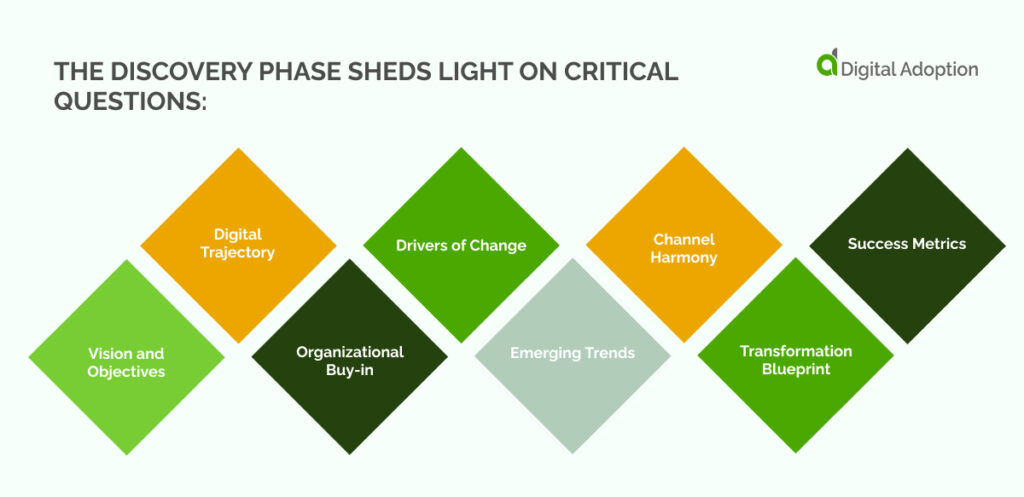
The discovery phase sheds light on critical questions:
- Vision and Objectives: Is our compass set? Do we share a clear vision and measurable goals?
- Digital Trajectory: Where do we stand on the innovation curve? Are we leading, lagging, or stuck in mediocrity?
- Organizational Buy-in: Have we engaged all the teammates in digital employee onboarding? Do we have unwavering support from all quarters?
- Drivers of Change: What tides of disruption – competition, customer demands, tech shifts – propel us forward?
- Emerging Trends: What digital horizons are rising, and how will they impact our voyage?
- Channel Harmony: Does our digital experience flow seamlessly across all touchpoints?
- Transformation Blueprint: How will we weave technology into our fabric? What tools and strategies will guide our evolution?
- Success Metrics: How will we gauge the wind in our sails – the true impact of our initiatives?
By answering these questions with laser focus, you transform the discovery phase from a mere pit stop into the launchpad for an enriching digital voyage. Embrace it, and watch your organization evolve from follower to fearless explorer in the boundless digital ocean.
What is the difference between digital transformation and digital maturity?
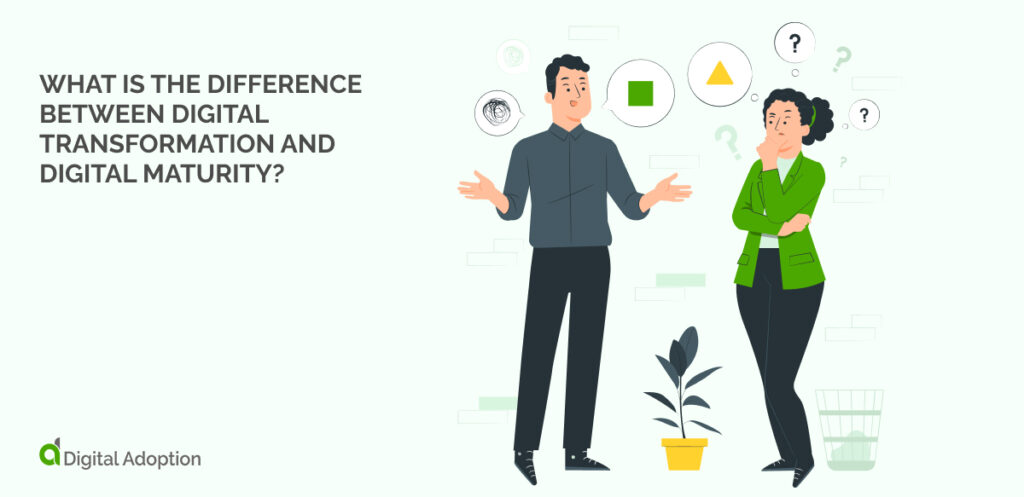
While often used interchangeably, “digital maturity” and “digital transformation” represent distinct, though intertwined, concepts. First, let’s look at digital maturity.
Digital maturity
Imagine a spectrum of digital adoption within an organization. Maturity sits somewhere along this spectrum, reflecting the degree to which digital technologies and processes permeate core operations, customer interactions, and innovation.
Indicators of high maturity include:
- Automated and digitized key processes: Streamlined workflows leveraging digital solutions.
- Data-driven decision-making: Utilizing analytics to inform strategic choices.
- Technology integration: Seamless interplay between existing systems and cutting-edge tools like robotics, AI, and IoT.
Digital transformation
Now, consider a proactive shift driven by these technologies. That’s the essence of digital transformation. It’s about fundamentally reshaping how an organization operates, creates value, and engages customers through strategic and comprehensive deployment of digital tools.
This process often involves:
- Rethinking business models: Adapting to evolving customer needs and market forces.
- Streamlining processes and structures: Optimizing for efficiency and agility.
- Investing in skills and capabilities: Fostering a culture of digital talent and expertise.
The key takeaway is that maturity measures integration, while transformation fosters change. While a mature organization leverages digital tools effectively, it may not be actively reshaping itself. Transformation, however, demands pushing beyond existing models and structures, venturing further into the digital frontier.
What do you do after you assess your digital transformation maturity?
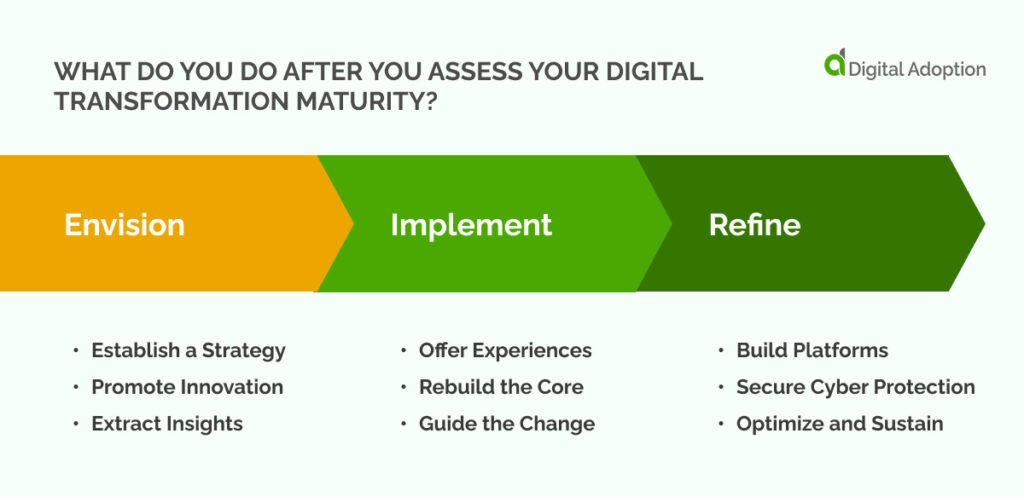
Although knowing where you sit on a digital maturity model is essential, knowing how to proceed with this information is equally valuable. There are three steps to ensure you optimize the results of your digital transformation maturity model outcome. The first step is to envision your strategy.
Envision
Unlocking your company’s digital potential starts with crystallizing its ambitions. Clearly define long-term goals and the desired future state you envision. Then, leverage the DMM framework as a compass, pinpointing areas of digital maturity that pave the way toward your aspirations.
Dive deeper, analyzing how to harness specific DMM capabilities to fuel strategic advantage. Finally, with these insights firmly grasped, craft a future-oriented vision – a clear and actionable roadmap guiding your digital transformation journey.
Establish a Strategy
Translate your DMM insights into a concrete roadmap. Align brand, growth, customer experience, and product strategies under a unified digital vision that capitalizes on identified strengths and addresses key areas for improvement.
Promote Innovation
Foster a culture of creative problem-solving. Define clear ideation and creative strategy processes to embed innovative thinking across all levels of the organization. Empower experimentation and leverage DMM findings to prioritize ideas with high potential impact.
Extract Insights
Go beyond internal data. Conduct comprehensive market, customer, employee, and competitor analyses to refine your digital direction. Use these insights to validate strategic decisions, identify emerging trends, and ensure your digital enterprise remains agile and responsive to evolving market dynamics.
Implement
The second step is to allow initial ideas to solidify into concrete prototypes, undergoing rigorous testing to validate their effectiveness. Based on those results, concepts are refined and optimized. This action informs the development of a comprehensive plan for future operating models to achieve scalability and drive substantial growth.
Offer Experiences
Elevate your digital presence beyond mere functionality. Design and deliver seamless omnichannel, mobile, and IoT experiences that cater to evolving customer needs, leveraging insights from the DMM to prioritize high-impact solutions and optimize engagement across all touchpoints.
Rebuild the Core
Don’t just paint the facade—Reimagine core business capabilities and processes through a digital lens. Analyze the DMM findings to identify bottlenecks and seize opportunities for automation, streamlining workflows, and creating a digital foundation primed for agility and scalability.
Guide the Change
Transformation isn’t just about tools: It’s about people. Embed digital DNA into the very fabric of your organization using a digital adoption platform (DAP) to encourage positive attitudes toward learning new technologies with in-app guidance. Utilize the DMM to assess and evolve your organizational design, fostering collaboration, breaking down silos, and nurturing a culture of continuous learning of digital transformation skills and adaptation to ensure lasting success.
Refine
With the foundation firmly set, the venture commences at the third stage—implementation soars, driven by your team’s combined vigor and dedication. Systems spring to life, processes adjust, and novel workflows establish themselves as the undertaking expands, yielding tangible benefits such as streamlined operations, heightened efficiency, and enriched customer experiences.
Build Platforms
Leverage the DMM insights to select and implement robust omni-channel and commerce platforms. Integrate seamless data security and cloud solutions, like a secure cloud fortress protecting your precious data, to ensure a strong foundation for future growth.
Secure Cyber Protection
Implement robust data protection, identity and access management, and advanced forensics solutions. Imagine these as vigilant guards patrolling your digital domain, equipped with cutting-edge tools to detect and neutralize any cyber threats, ensuring the safety and integrity of your operations.
Optimize and Sustain
Deploy flawless organizational changes and platform integrations, like well-oiled gears powering your digital engine. Continuously monitor and optimize performance, using DMM findings to identify areas for improvement, ensuring long-term value realization and sustained business agility, keeping your digital journey on an upward trajectory.
The ongoing commitment to digital maturity and organizational excellence
The essence of digital maturity lies in the seamless fusion of advanced technologies and a progressive corporate mindset.
It goes beyond technological adoption, representing a holistic transformation that permeates every facet of operations. A digitally mature organization leverages cutting-edge tools and nurtures a culture of adaptability, innovation, and customer-centricity.
This transformative journey propels businesses towards sustained growth and resilience in dynamic market shifts. As processes evolve and workforce capabilities align with digital advancements, the organization becomes inherently equipped to navigate complexities and proactively respond to emerging challenges.
Digital maturity isn’t just a milestone; it’s an ongoing commitment to staying at the forefront of technological innovation and organizational excellence, ensuring enduring success in the face of digital adversity.

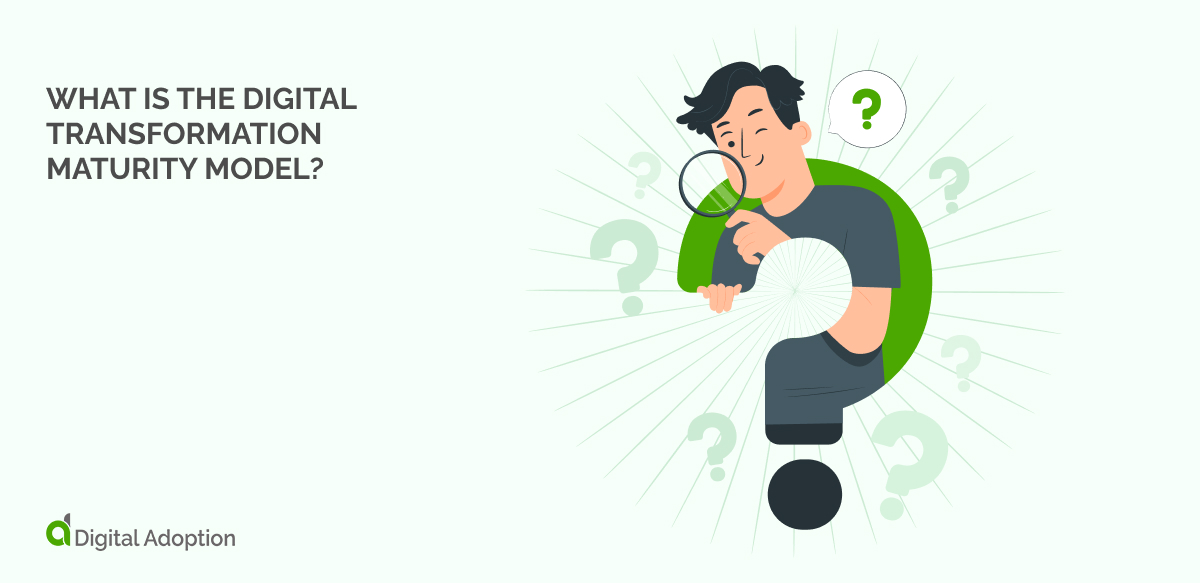



![18 Examples of AI in Finance [2025]](https://www.digital-adoption.com/wp-content/uploads/2025/06/18-Examples-of-AI-in-Finance-2025-300x146.jpg)
![14 Examples of AI in Manufacturing [2025]](https://www.digital-adoption.com/wp-content/uploads/2025/06/14-Examples-of-AI-in-Manufacturing-2025-300x146.jpg)
![29 Examples of AI in Education [2025]](https://www.digital-adoption.com/wp-content/uploads/2025/06/29-Examples-of-AI-in-Education-2025-300x146.jpg)
![15 Examples of AI in Retail [2025]](https://www.digital-adoption.com/wp-content/uploads/2025/06/15-Examples-of-AI-in-Retail-2025-300x146.jpg)



![18 Examples of AI in Finance [2025]](https://www.digital-adoption.com/wp-content/uploads/2025/06/18-Examples-of-AI-in-Finance-2025.jpg)
![14 Examples of AI in Manufacturing [2025]](https://www.digital-adoption.com/wp-content/uploads/2025/06/14-Examples-of-AI-in-Manufacturing-2025.jpg)